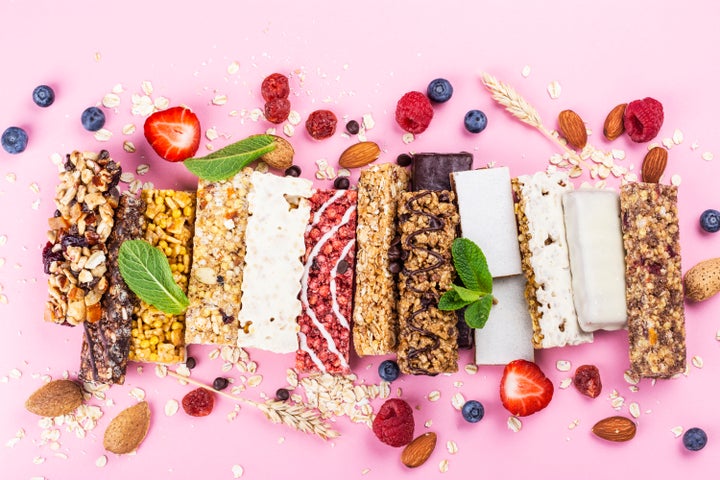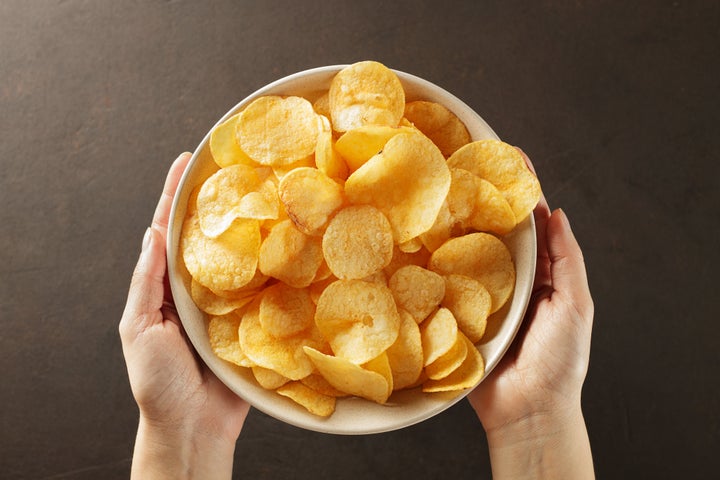Not all prepackaged snack foods are sugar or calorie bombs, but weeding out the healthy options from the unhealthy can be a tricky business.
“Snack foods are often labeled and marketed in a way that lead the public to believe the food item is a healthy choice, when this isn’t always the case,” said Tasha Temple, a registered dietitian at Northside Hospital Gwinnett in Lawrenceville, Georgia.
That’s why it’s so important to read labels and not only understand the names of ingredients, but what they’re providing (or not) nutritionally.
What to look for in nonperishable snacks
Start by paying attention to the serving size and understand that all of the information listed is in relation to that portion. Then, take note of the “% daily value” for each nutrient.
“Anything 5% or less is considered low and anything 20% or higher is considered high,” Atlanta-based registered dietitian Sarah Marjoram told HuffPost. This is an especially handy tidbit when checking out how much salt and sugar a specific snack contains.
“Another good rule of thumb is a simple ingredient list,” Marjoram added. “Fewer ingredients typically indicates a healthier product.”
As for how to distinguish between healthy and unhealthy versions of specific snack foods, here’s a rundown of the criteria experts recommend as you’re reading their labels in real time.
Granola bars
Look for granola bars that are between 100-200 calories, reasonably low in carbs (roughly 15 grams per bar), contain 3 grams or more of fiber (5-7 grams is ideal, Temple said) and at least 6 grams of protein.
Avoid bars that have lengthy ingredient lists — the shorter the list and simpler the ingredients (whole grains, nuts, seeds, honey, maple syrup), the better.
Steer clear of bars that contain high fructose corn syrup, an ingredient that’s been linked to weight gain and insulin resistance.

Also avoid hydrogenated oils, also known as trans fats, which have been linked to an increased risk of heart disease.
“Trans fats can be hidden ingredients due to a loophole in nutritional labeling that states if there’s less than 0.5 grams per serving in a product, the producer can label the food as having 0 grams of trans fat,” Temple said. “This can be troubling because recommendations encourage removing all forms of trans fat from your diet.”
Trail mix
Go with a trail mix that consists mostly of nuts and seeds, with dried fruit or dark chocolate chips making only a minor appearance in the mix.
The ingredient list itself should contain only simple ingredients. “If you see one or more types of sugar on the label (cane sugar, corn syrup, honey, maple syrup), look for a different one,” Chicago-based registered dietitian Maggie Michalczyk told HuffPost.
Ideally, you want to look for a trail mix that’s low in sodium (140 milligrams per serving or less) and contains little to no added sugars, as even the healthiest trail mix is calorie-dense: A standard portion is only 1/4 cup and can range anywhere from 150-200 calories, Temple said.
Crackers
Look for cracker varieties that are higher in fiber, which helps boost satiety ― look for about 5 or more grams of fiber per serving.
“Crackers with a higher fiber content tend to come from whole sources of grains, so make sure these are the first things you see on the nutrition label,” Temple said. Think whole wheat, whole grain, brown rice flour, or the word “whole” followed by a specific grain.
Other nutrient-dense ingredients to look for at the start of the list are vegetables, nuts and seeds.
“If the product lists the words ‘bleached’ or ‘enriched’ first, then it isn’t a ‘whole’ product even if it’s advertised as such,” Temple said. You also want to make sure the crackers aren’t high in sodium or added sugars.
“Ideally, look for crackers with a maximum of six ingredients,” Temple suggested.
Jerky
Even though there are many different types of jerky these days (beef, turkey, salmon, vegan), one isn’t necessarily healthier than the other.
“All jerky options are low in carbs and high in protein, but have the downside of being super high in sodium because they’ve been cured,” Temple said. One ounce of plain jerky (roughly the size of a credit card) can contain around 500 milligrams of sodium, which is around 25% of the Food and Drug Administration’s recommended daily amount.
When searching for good jerky options for snacking, look for ones that are organic with whole food ingredients you recognize, contain less than the average 500 milligrams of salt, and are low in sugar (say, 2 grams or less per serving), especially if you prefer flavored varieties, which typically contain more sugar than plain ones.
Avoid varieties that contain nitrates (a compound that’s been linked to cancer), are high in sugar (stay under 2 grams per serving) and contain any ingredients you don’t recognize.
Nuts
Look for raw or dry roasted options that are either lightly salted or unsalted, and check to make sure the ingredients list is recognizable and as short as possible.
If flavored nuts are more your thing, avoid varieties that are high in sodium (anything over 140 milligrams per serving) and added sugars (if the nuts contain more than 5-7 grams of added sugar per serving, it’s best to steer clear).
Chips
Even though there are plenty of brands that are improving the healthfulness of chips, “they’re still considered one of the least healthy snack options,” Temple said.

Still, cravings happen, in which case look for chips that are baked or dehydrated (say, kale chips). Chips that list whole grains as the first ingredient are a good choice too, since that means they’re higher in fiber, Marjoram said.
Aim for a minimum of 3 grams of fiber and protein per serving, and make sure the ingredients list is limited and only contains ingredients you recognize.
Avoid chips that contain saturated fats, hydrogenated or partially hydrogenated oils and are high in sodium and added sugars.
Popcorn
Popcorn alone is a great snack choice — it’s made of a whole grain that’s 100% unprocessed and naturally low in fat and calories, Temple said. One 3-cup serving can provide you with anywhere from 3 to 6 grams of fiber.
The fewer the ingredients in your pre-popped picks, the better — ideally, corn, oil and (a minimal amount of) salt, Michalczyk said, with a minimum of 3 grams of both protein and fiber per serving. And no matter the flavors you gravitate toward, make sure they’re made from real food, as opposed to artificial flavors.
Steer clear of varieties that are high in sodium (over 300 milligrams per serving) and saturated fat (more than 2 grams), or contain added sugars and trans fats (no partially hydrogenated anything!).
Protein bars
“When choosing a protein bar as a meal replacement, go for one with 20 to 30 grams of protein and less than 45 grams of carbs,” Temple said. “When eating one as a snack, make sure it includes at least 10 grams of protein and 30 grams of carbs or less.”
To stay full even longer, opt for bars that contain 3 grams or more of fiber, and for blood sugar stability, aim for no more than 6-8 grams of sugar per bar.
Protein sources should be represented first on the ingredients list (with whey protein, pea protein and eggs representing a few good sources) and all ingredients should be whole and easily identifiable (oats, quinoa, nuts, seeds, dried fruit).
Avoid protein bars that include soy protein isolate and any form of sugar (such as brown rice syrup) as the first ingredients. “I always recommend opting for whole food soy sources like tofu, tempeh or miso as opposed to soy protein isolate,” said Chicago-based integrative dietitian Krista King. (Soy is also a common food sensitivity, she added.)
Be mindful to avoid bars with words like “high fructose corn syrup” and “hydrogenated oils” on the ingredients list, as well as sugar alcohols, like xylitol and sorbitol, which are known to cause gastrointestinal upset.
Oatmeal cups
The only downside of oatmeal is that it’s bland, but most tasty versions include added sugar and fat, which can reverse all of the amazing health benefits of eating it as a snack.

“To preserve the nutrient quality in an oatmeal cup, consider looking for ones that are less than 250 calories, roughly 30 grams of carbs (with 6 or more grams coming from dietary fiber) and at least 6 grams of protein,” Temple said.
When looking at the ingredients, oats or the word “whole” should be first on the list. You should also be able to recognize the rest of the ingredients.
“Unrecognizable descriptors typically mean the product is loaded with additives and preservatives,” Temple said. (Michalczyk recommended sticking with the plain varieties versus the flavored ones to avoid added sugars, and instead add your own flavorful toppings, like blueberries, almonds and ground flaxseed.)
Dried fruit
When you’re buying dried fruit, there should only be one ingredient, and that’s the dried version of the fruit you’re buying.
“On the nutrition label, all dried fruits will have sugar (because they’re natural sugars), so make sure to pay close attention to the ‘added sugar’ section,” said Temple.
Nut butter packets
At the most, the nut butter packets you choose should only contain your nut of choice (peanuts, almonds, cashews) and possibly salt, so long as you don’t have a health condition that requires minimizing your salt intake — and those are the only two ingredients that should be on the list.
Avoid nut butters that contain added sugars or reduced-fat versions. “When something is reduced in fat, usually sugar is added to the product so that it still tastes good,” King said.
Roasted chickpeas
Even though this snack is rich in fiber, protein, folate and phytonutrients, roasted chickpeas, like all prepackaged foods, come in healthy and not-so-healthy options.
Ideally, you should only see two ingredients on the label: garbanzo beans and sea salt.
“Limit sodium to less than 300 milligrams per portion and less than 150 milligrams if you’re living with a medical condition that requires sodium intake reduction,” Temple said.
If you prefer roasted chickpea seasonings that have more kick, make sure to choose flavors that are super low in added sugars (no more than 5 grams per serving).